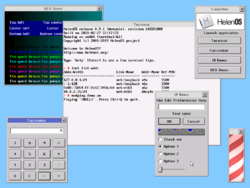HelenOS facts for kids
 |
|

Example applications
|
|
| Programmed in | C |
|---|---|
| OS family | Multiserver operating systems |
| Source model | Open source |
| Initial release | June 11, 2006 |
| Latest unstable release | 0.14.1 |
| Package manager | coastline packages |
| Supported platforms | IA-32, AMD64, IA-64, ARM, MIPS, PowerPC, SPARC V9, RISC-V |
| Kernel type | Microkernel |
| License | BSD-3-Clause |
HelenOS is a special kind of operating system. Think of an operating system as the main program that makes your computer work. HelenOS is built in a unique way, using something called a "multiserver microkernel" design.
This means it's made up of many small, separate parts that work together. The main code for HelenOS is written in a computer language called C. It's also open source, which means its code is free for anyone to see and use.
Contents
How HelenOS Works
HelenOS uses a "microkernel." This is a tiny core part of the operating system. It handles the most basic jobs. These jobs include running many programs at once (called multitasking). It also manages the computer's memory. And it helps different parts of the system talk to each other.
Building Blocks of the System
Imagine building a computer system with LEGO bricks. In HelenOS, each important part is like a separate LEGO brick. Things like file systems (how files are stored), networking (connecting to the internet), and device drivers (programs that help hardware work) are all separate. Even the graphics you see on screen are separate.
These separate parts are called "user space components." They communicate by sending messages back and forth. This design makes the system very stable. If one part crashes, it usually doesn't bring down the whole system.
Tasks and Threads
In HelenOS, a running program is called a "task." Each task can have several "threads." Threads are like mini-programs within a task. The microkernel helps these threads take turns using the computer's processor.
Device drivers and other system services are also tasks. They run separately from each other. This is why HelenOS is called a "multiserver" system. It has many small "servers" working together.
How Parts Talk to Each Other
The different parts of HelenOS talk using something called "HelenOS IPC." IPC stands for "Inter-Process Communication." It's like a special messaging system.
This system lets parts send small messages. They can also share bigger blocks of data. It's designed to be efficient. This means messages can be sent quickly without wasting computer resources.
Developing HelenOS
HelenOS is developed by a community of people. This means many different people contribute to making it better. The main team includes staff and students from Charles University in Prague. Many other people from around the world also help out.
Community Projects
HelenOS has been part of some cool programs. It participated in the Google Summer of Code several times. This program helps students work on open-source projects. It was also part of the ESA Summer of Code in Space program. These programs help new developers learn and contribute.
Open Source and Licenses
The main code for HelenOS is available under the BSD-3-Clause license. Some other parts use the GNU General Public License. Both of these are "free software licenses." This means HelenOS is free software. Anyone can use it, study it, change it, and share it.
What Hardware HelenOS Supports
HelenOS can run on many different types of computer processors. These include common ones like ARM (found in phones) and x86-64 (found in most desktop computers). It also supports older or more specialized processors like IA-32, IA-64 (Itanium), MIPS, PowerPC, SPARC V9, and RISC-V.
At different times, HelenOS has run on real hardware for each of these types. It doesn't just run in a simulator.
Supported Devices
HelenOS also works with many different computer parts. It supports various types of hard drives, like PATA and SATA. It works with USB mass storage devices (like flash drives) and USB HID devices (like keyboards and mice).
It can also connect to the internet using some WiFi dongles and Ethernet cards. For sound, it supports devices like SoundBlaster 16 and Intel HDA. It also works with serial ports and screen displays (framebuffers).
Research and Learning
HelenOS is used for research at Charles University in Prague. Scientists there use it to study how software parts work together. They also use it to check if software is reliable.
Students also use HelenOS for their projects. It's a great platform for learning about operating systems. Many students have used it for their master's theses.

